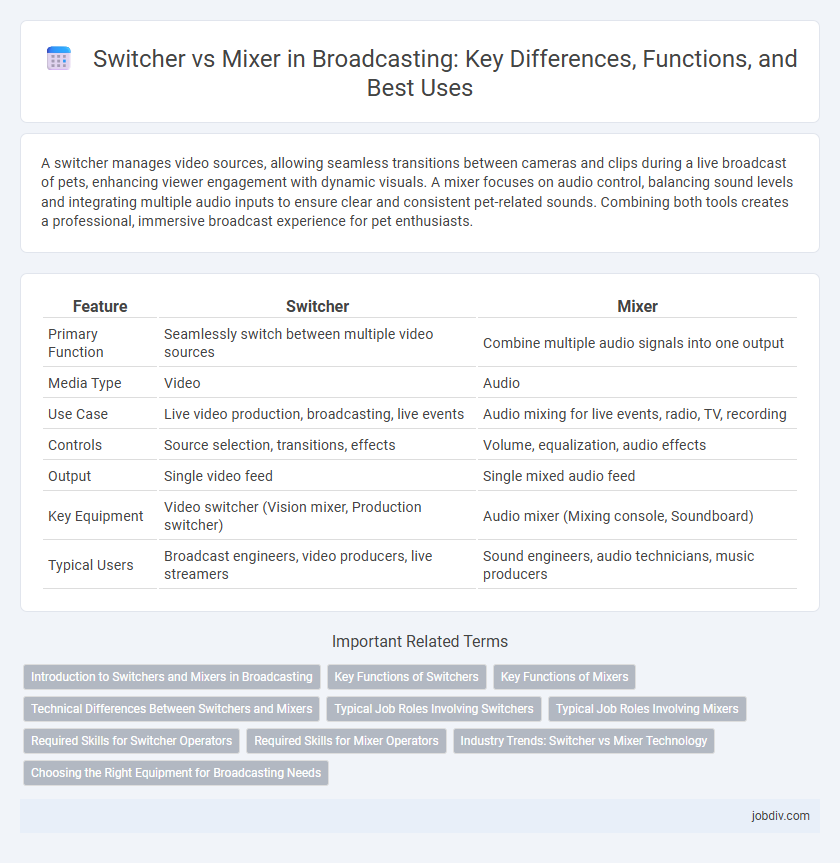A switcher manages video sources, allowing seamless transitions between cameras and clips during a live broadcast of pets, enhancing viewer engagement with dynamic visuals. A mixer focuses on audio control, balancing sound levels and integrating multiple audio inputs to ensure clear and consistent pet-related sounds. Combining both tools creates a professional, immersive broadcast experience for pet enthusiasts.
Table of Comparison
| Feature | Switcher | Mixer |
|---|---|---|
| Primary Function | Seamlessly switch between multiple video sources | Combine multiple audio signals into one output |
| Media Type | Video | Audio |
| Use Case | Live video production, broadcasting, live events | Audio mixing for live events, radio, TV, recording |
| Controls | Source selection, transitions, effects | Volume, equalization, audio effects |
| Output | Single video feed | Single mixed audio feed |
| Key Equipment | Video switcher (Vision mixer, Production switcher) | Audio mixer (Mixing console, Soundboard) |
| Typical Users | Broadcast engineers, video producers, live streamers | Sound engineers, audio technicians, music producers |
Introduction to Switchers and Mixers in Broadcasting
Switchers and mixers play crucial roles in broadcasting by managing video and audio sources for live productions. A switcher enables seamless transitions between multiple video feeds, allowing for real-time control of camera shots, graphics, and effects. Mixers combine various audio inputs to balance sound levels, ensuring clear and professional audio output throughout a broadcast.
Key Functions of Switchers
Switchers primarily enable seamless transition between multiple video sources during live broadcasts, providing real-time control over input selection. They support key functions such as video layering, picture-in-picture effects, and transitions, facilitating dynamic visual storytelling. Unlike mixers, switchers focus on source selection and layout management rather than detailed audio processing.
Key Functions of Mixers
Mixers combine multiple audio or video sources into a single output, allowing precise control over levels, transitions, and effects to enhance production quality. Key functions include adjusting input signals, applying equalization, and managing routing for seamless broadcasting workflows. Unlike switchers that primarily select sources, mixers ensure balanced and dynamic content delivery through real-time signal manipulation.
Technical Differences Between Switchers and Mixers
Switchers primarily handle video source selection and transitions in live broadcasting environments, enabling seamless switching between multiple camera feeds or video inputs. Mixers focus on audio signal processing by combining, adjusting levels, and applying effects to multiple audio channels to produce a balanced sound output. Technical differences include that switchers operate with video signals using electronic or digital crosspoints, whereas mixers process analog or digital audio signals through faders, equalizers, and routing buses.
Typical Job Roles Involving Switchers
Switcher operators play a crucial role in live broadcast production, managing video source selection and transitions to ensure seamless program flow. They work closely with directors and technical crews to execute real-time video effects and overlays during live events. Typical job roles include live event producers, technical directors, and vision mixers who rely heavily on switchers to control multi-camera setups.
Typical Job Roles Involving Mixers
Mixers are essential in live broadcasting environments, where audio engineers and sound technicians manage sound levels and integrate multiple audio sources to ensure clear, balanced output. Broadcast engineers utilize mixers to adjust microphone inputs, background music, and sound effects during live shows or recorded productions. These professionals rely on mixers for precise control over audio quality, enabling seamless transitions and professional-grade sound delivery.
Required Skills for Switcher Operators
Switcher operators must possess advanced multitasking abilities to seamlessly manage live video feeds, transitions, and effects in real time. Proficiency in technical knowledge of broadcast equipment, including familiarity with software interfaces and signal routing, is essential for maintaining production quality. Quick decision-making skills and attention to detail enable operators to respond promptly during live broadcasts, ensuring smooth and professional content delivery.
Required Skills for Mixer Operators
Mixer operators require precise technical skills, including audio signal flow management, sound balancing, and real-time adjustments to maintain audio clarity during live broadcasts. Expertise in using digital audio workstations (DAWs) and familiarity with various audio effects and routing configurations are essential for optimal sound mixing. Strong communication skills and the ability to collaborate with producers and technical teams ensure smooth operation and high-quality broadcast audio output.
Industry Trends: Switcher vs Mixer Technology
Switcher technology in broadcasting is evolving with integrated IP workflows and advanced automation, enabling seamless multi-source video switching and real-time effects. Mixers continue to innovate by enhancing audio signal processing with digital control interfaces and immersive sound capabilities, meeting the demand for high-fidelity audio in live productions. Industry trends indicate a convergence where modern switchers incorporate mixing functions, streamlining production workflows and improving overall efficiency.
Choosing the Right Equipment for Broadcasting Needs
Selecting the right broadcasting equipment depends on whether you need a switcher or mixer, as each serves distinct functions in live production. A switcher primarily manages video feeds, allowing seamless transitions between multiple camera angles, while a mixer handles audio signals, balancing and adjusting sound levels for clear transmission. Understanding your content requirements and technical setup ensures optimal equipment choice to enhance broadcast quality and workflow efficiency.
Switcher vs Mixer Infographic

 jobdiv.com
jobdiv.com